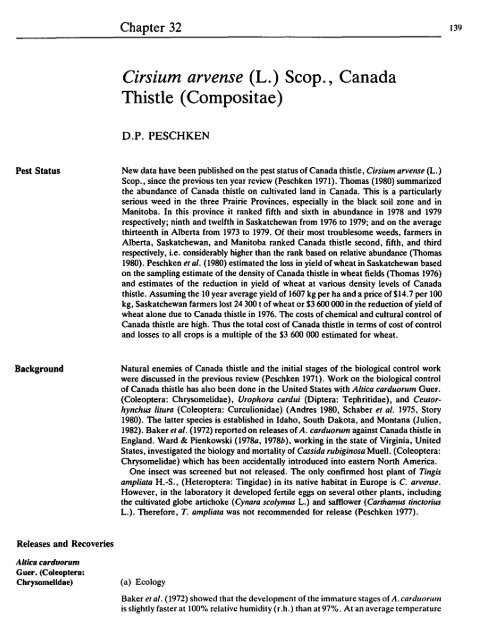pdf, 57.71Mb - Entomological Society of Canada
pdf, 57.71Mb - Entomological Society of Canada
pdf, 57.71Mb - Entomological Society of Canada
You also want an ePaper? Increase the reach of your titles
YUMPU automatically turns print PDFs into web optimized ePapers that Google loves.
Pest Status<br />
Background<br />
Releases and Recoveries<br />
Altics csrduorum<br />
Guer. (Coleoptera:<br />
Chrysomelidae)<br />
Chapter 32<br />
Cirsium arvense (L.) Scop., <strong>Canada</strong><br />
Thistle (Compositae)<br />
D.P. PESCHKEN<br />
New data have been published on the pest status <strong>of</strong> <strong>Canada</strong> thistle, Cirsium arvense (L.)<br />
Scop., since the previous ten year review (Peschken 1971). Thomas (1980) summarized<br />
the abundance <strong>of</strong> <strong>Canada</strong> thistle on cultivated land in <strong>Canada</strong>. This is a particularly<br />
serious weed in the three Prairie Provinces, especially in the black soil zone and in<br />
Manitoba. In this province it ranked fifth and sixth in abundance in 1978 and 1979<br />
respectively; ninth and twelfth in Saskatchewan from 1976 to 1979; and on the average<br />
thirteenth in Alberta from 1973 to 1979. Of their most troublesome weeds, farmers in<br />
Alberta, Saskatchewan, and Manitoba ranked <strong>Canada</strong> thistle second, fifth, and third<br />
respectively, i.e. considerably higher than the rank based on relative abundance (Thomas<br />
1980). Peschken et al. (1980) estimated the loss in yield <strong>of</strong> wheat in Saskatchewan based<br />
on the sampling estimate <strong>of</strong> the density <strong>of</strong> <strong>Canada</strong> thistle in wheat fields (Thomas 1976)<br />
and estimates <strong>of</strong> the reduction in yield <strong>of</strong> wheat at various density levels <strong>of</strong> <strong>Canada</strong><br />
thistle. Assuming the 10 year average yield <strong>of</strong> 1607 kg per ha and a price <strong>of</strong>$14.7 per 100<br />
kg, Saskatchewan farmers lost 24 300 t <strong>of</strong> wheat or $3 600 000 in the reduction <strong>of</strong> yield <strong>of</strong><br />
wheat alone due to <strong>Canada</strong> thistle in 1976. The costs <strong>of</strong> chemical and cultural control <strong>of</strong><br />
<strong>Canada</strong> thistle are high. Thus the total cost <strong>of</strong> <strong>Canada</strong> thistle in terms <strong>of</strong> cost <strong>of</strong> control<br />
and losses to all crops is a multiple <strong>of</strong> the $3 600 000 estimated for wheat.<br />
Natural enemies <strong>of</strong> <strong>Canada</strong> thistle and the initial stages <strong>of</strong> the biological control work<br />
were discussed in the previous review (Peschken 1971). Work on the biological control<br />
<strong>of</strong> <strong>Canada</strong> thistle has also been done in the United States with Altica carduorum Ouer.<br />
(Coleoptera: Chrysomelidae), Urophora cardui (Diptera: Tephritidae), and Ceutorhynchus<br />
Iitura (Coleoptera: Curculionidae) (Andres 1980, Schaber et al. 1975, Story<br />
1980). The latter species is established in Idaho, South Dakota, and Montana (Julien,<br />
1982). Baker et al. (1972) reported on releases <strong>of</strong> A. carduorum against <strong>Canada</strong> thistle in<br />
England. Ward & Pienkowski (1978a, 1978b), working in the state <strong>of</strong> Virginia, United<br />
States, investigated the biology and mortality <strong>of</strong> Cassida rubiginosa Muell. (Coleoptera:<br />
Chrysomelidae) which has been accidentally introduced into eastern North America.<br />
One insect was screened but not released. The only confirmed host plant <strong>of</strong> Tingis<br />
ampliata H.-S., (Heteroptera: Tingidae) in its native habitat in Europe is C. arvense.<br />
However, in the laboratory it developed fertile eggs on several other plants. including<br />
the cultivated globe artichoke (Cynara scolymus L.) and safflower (Carthamus tinctorius<br />
L.). Therefore, T. ampliata was not recommended for release (Peschken 1977).<br />
(a) Ecology<br />
Baker et al. (1972) showed that the development <strong>of</strong>the immature stages <strong>of</strong> A. carduorultl<br />
is slightly faster at 100% relative humidity (r.h.) than at 97%. At an average temperature<br />
139
















